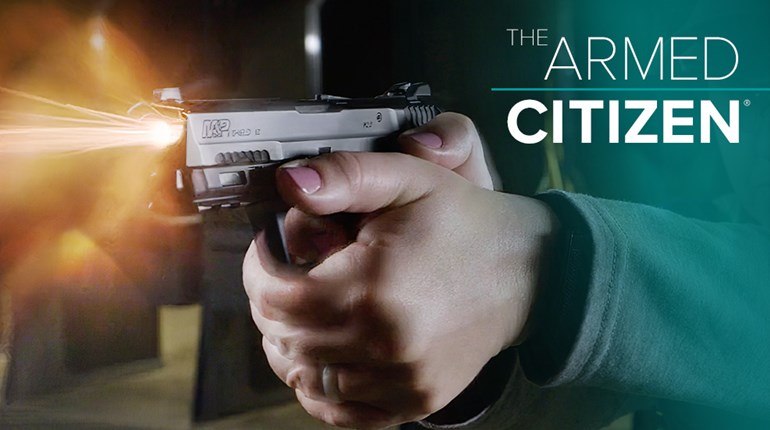
Real life involves moving around the obstacles of the world like walls, fences, corners, cars—you name it. Gun fighting in real life presents the same challenges. Standing still is lethal, so movement is key and that means running through natural terrain as fast as you can. The world is not square with range markers in plain sight, and neither is the Follow Through Consulting range in Teasdale, UT.
Crouching behind the first hay bale in preparation for a stress course, you search the area waiting for Buck Doyle to provide your instructions. You’re checking your magazine and sights, and remaining vigilant. Once you know what to engage, you pop up, get hits on target and quickly move back behind cover. Focused on the fight, you listen, watch and prepare.
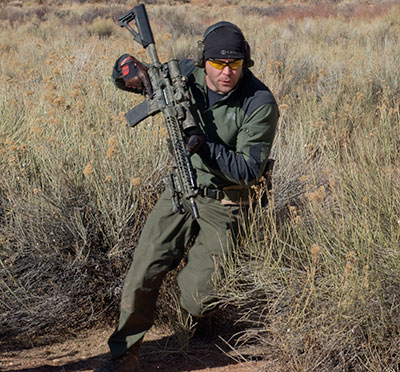
Mindset is critical; it’s not just about hitting the steel. Doyle tells you where to go next. You see where to go, figure out how to get there and run through 6 inches of snow as fast as you can to the next point of cover to do it all again. Heart pumping, scope reticle bouncing up and down, snow blowing across your face, looking through the fog you set up and nail the 10-inch plate at 300 meters. It’s day three of Follow Through Consulting Scoped Carbine class and you own it, even in a driving snowstorm. You’re training at the speed of life, and it is fantastic.
Most quality training I’ve recently attended have more similarities than differences. New techniques are mostly re-worked with new concepts that have existed for decades. Largely market driven, “new and improved” sells classes. It has prompted techniques with names, systems that are not systematic and hyperbole extraordinaire. It’s as much selling as teaching—more marketing than training and more personality than substance.
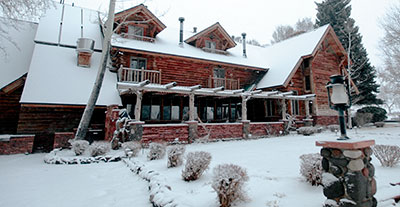
Secondly, most current training is about function, not application. Practicality dictates that to a degree; you need to learn to operate the firearm before you can apply it. Beginning classes should be skill-based, but as you progress, application becomes critical. It’s like learning to drive while never actually driving a car. Too often, the billing for application in an “advanced” class turns into a skill-based training with an hour focused on application. Occasionally, that norm is reversed, and Buck Doyle’s Follow Through Consulting is an excellent example.
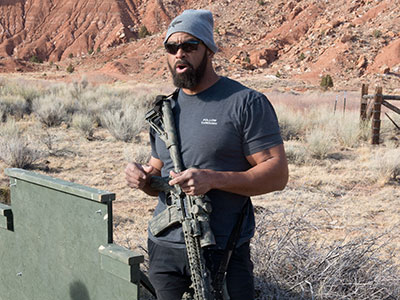
Follow Through Consulting
Think of a hardened Marine—physically fit, mentally sharp and focused on real-world application—and you get Buck Doyle. Twenty-plus years as a Marine, much of it in Force Recon, followed by years as a contractor leave Doyle with more “been there done that” than most living humans. Having endured multiple deployments and spent significant time as a trainer, as well as sustaining battle wounds, he is a true combat survivor. He is friendly, professional and personable, with a strong basis in family and faith. He neither wears his experience on his sleeve nor throws it in your face; it is just evident with every word and action. So why is this important? It personifies his doctrine, one seldom seen in these days of slick marketing, Internet videos and manufactured backgrounds. There’s no class time filled with endless war stories. In fact, you are hard-pressed to get him to talk about himself. For me, it is refreshing and important to know I’m dealing with the real deal prior to attending training, and that the real deal isn’t self-aggrandizing.
Foundation and Doctrine
Attend a Follow Through Consulting basic class and you will not come away with anything earth-shattering or strikingly new. More the norm than most would admit, Doyle tells you that right up front. He teaches what he learned from talking with hardened combat veterans who survived the crucible of war—tempered by his own experience on the same fields of battle. His lessons are simple, proven and practical—devoid of mind-numbing drills. Subsequent classes build on the application of these skills and instill his basic doctrine. It is characterized as Shoot, Move and Communicate. This was actually taught to me by Clint Smith, another combat Marine, almost two decades prior, and it remains critical to survival. With a few subtle differences, it permeates Doyle’s entire curriculum.
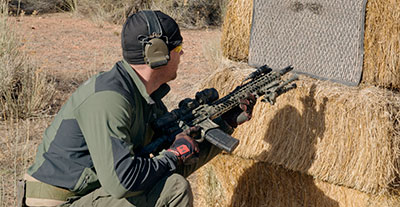
Follow Through Training
Shooting skill equates to solid hits on target given real-world conditions under stress, while on, in or moving around natural terrain. Targets are man-size or smaller, without regard to range. Know your equipment and how to apply it—using the latest technology where possible—including modern reticles and ballistic programs. While you may not consult your favorite device during a fight, it can still be used to ensure your holds are accurate given the conditions present. This allows you to apply the knowledge gained in training when knob-turning and electronic consultation are not possible.
Movement is purposeful and pragmatic. If you are looking for something, look—no mindless head swinging. Move to a destination with a way to get there, and a reason to go. Move with purpose whether toward or away from the target, taking angles and terrain into consideration. Practice for the conditions you might encounter.
While doing all this, you must keep your mind in the fight. This is not about yelling predetermined phrases. Staying “in the fight” means keeping your mind engaged, thinking about where to go, how to get there, how to survive and how to win. Communicate with partners or team members. That may mean verbally, with hand signals or just through a knowledge born of constant training together. Maybe it’s just a look or an action; it is not always some agreed-upon set of terms. Fighting is seldom static or contrived. Learning to communicate in a changing environment is vital.
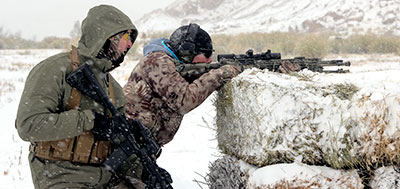
Scoped Carbine “Lite”
Scoped Carbine is focused on optics-equipped 5.56 NATO (or similar) ARs designed for accurate fire, similar to an SPR or DMR. It’s not a “basic” class; some operational skills are required. Doyle will tailor the class to an extent based on his foundation, but it is mostly an application school. Very little time (less than a couple of hours) is spent in the classroom. Training is on the range, and not just “making brass”—each segment is designed to teach you something about you, your firearm, optic or gear. Shooters at any level will gain knowledge, those with greater experience will likely benefit more. While some skills may transfer to the field of competition their application will be counterintuitive to the sport.
Follow Through Consulting’s range in Teasdale is a big part of this class. It provides a place to apply skills most ranges cannot duplicate. Working a square range makes it easy to “check out” when performing drills ad nauseam. Passable when skill building, it does little to test application. Actions are too often completed “as expected,” with little thought beyond “you told me to.” Training at Teasdale all but eliminates that. Nothing is square, level is rare and “drills” are limited. As a writer, it’s a perfect opportunity for testing different rifles, calibers, scopes and reticles under the same conditions. If you’re running the same gun, by the end of class you will know what works and doesn’t.
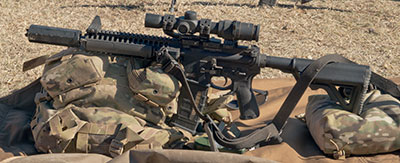
A Testing Dream
I brought three rifles out to Teasdale. All required reticle use for elevation and wind holds fitting within Doyle’s overriding doctrine—no time for knobs, need to find it, range it, hold and shoot it.
My LWRC 12.7-inch-barreled Six8 rifle (in 6.8 Rem. SPC) used Federal 90-grain Gold Dot ammunition—its current duty load. A U.S. Optics 1.5-6X SR6 scope with the JNG Mil reticle topped it off. There was no bipod; prone was unsupported or a deployment bag was used.
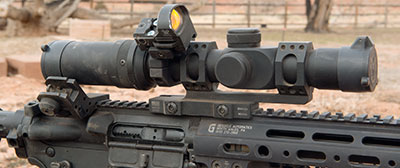
My second rifle was built on an old duty M16 using a Geissele handguard and trigger with an FNH USA 16-inch commercial barrel. I mounted a U.S. Optics 1-8X SR8 scope using a Horus H50 reticle and lighted center dot on it. This solid duty rifle was built using only those tools a department armorer would have on hand. An Atlas bipod was attached. Nosler 64-grain bonded 5.56 NATO, a typical police deployment round, was its preferred fodder.
Lastly, I brought my Red Creek Tactical Apache LTC with a Trijicon VCOG. Loaded with Black Hills 77-grain TMK, it is nicely accurate with its 16-inch Lilja barrel.
All of the carbines were equipped with suppressors—the LWRC and Red Creek used OSS-Mission Gen 4 suppressors, while the M16 employed a Delta P Designs Brevis Model.
Application in Action
Since this class was dedicated to 5.56 NATO or similar chamberings, ranges stayed inside of 500 meters. Testing first-round hits with the help of my Applied Ballistics Kestrel wind meter, the Six8 came out of the truck on target. Proper holds were calculated for windage and elevation, then applied. Hold, one trigger press, one dead-center hit on target. Winds reached in excess of 20 mph, making the Kestrel particularly valuable. This scenario was repeated over eight targets from 200 to 400 meters, with only one miss at the longest range.
Once dialed in, we hiked to an area requiring shooting across a valley with a winding river, making wind reads even more difficult. You could lie prone, but you’d be canted and angled. Making proper use of previous holds to knock targets down was the task. Using previously confirmed knowledge, we applied a recently acquired skill to a different condition, building up skills each time and weeding out those that don’t work. We had pretty much the same results—first-round hits, with no one needing more than two shots to get on steel. It was a great start to the class, with much to learn and consider for the next day.
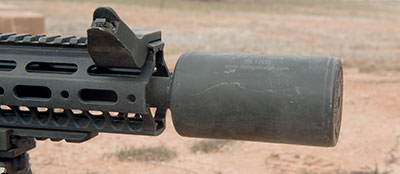
Movement and Increased Heart Rate
Gunfights add stress, increasing your heart rate whether you move or not. Static targets are easier to hit, so moving is most definitely a good thing. Most of the day required starting from a hay bale and engaging targets from 25 to 300 meters, moving to a different position and repeating as needed. Doyle tells you where to go, what to shoot and how many times to shoot it, keeping your mind engaged. You can’t just run from place to place shooting. At each station you stay behind cover, checking your surroundings. No rush, no timer—just engaged thought. Look where you need to go, decide how
to get there, determine what to do upon arrival, then do it. You could run, jog, whatever matches your fitness level, you just need to get your heart rate up. Positions were seldom textbook, although prone was used as a rule on the 300-meter targets. That 10-inch target got smaller after a long sprint up the hill, showing how fitness is every bit as important as shooting skill.
Using the FN-barreled rifle with 64-grain duty ammo, its limitations became noticeable, especially as the range increased. Windage and elevation holds were increased compared to the others, and beyond 300 meters the flat-nose bullet became a liability. Add crosswinds, shooting sideways across the canyon, and it was worse. Using the Black Hills 77-grain TMK, the difference was immediately evident. It was faster, hit harder and cut down on wind holds at range. That’s just something to understand when using issued ammunition. On the other hand, the Horus reticle was perfect for these conditions. Instead of holding in blank space in the reticle, actual holds were possible. Having the red dot on lower power was also helpful, even on the targets inside of 300 meters. The Kestrel was again dead-on—input data, follow it and you will achieve regular hits.
Mother Nature Strikes Back
Teasdale sits at about 6,500 feet above sea level amongst the red rock cliffs of central Utah. Winter had been a bit light until we woke up to 6 inches of snow on the ground, and a steady storm upped the stakes. Running through the same courses of fire in snow presented obvious differences. Adding gear, using scopes with snow or fog on the lenses and holding on a flat background all piled on the stress. Sprinting in fresh snow is much like running on the beach, so that was also a bit more challenging.
In our time in Red Creek, I learned a solid lesson regarding reticles with windage compensating marks. I hadn’t experienced wind of this duration, so my holds incorporated a bit of “Kentucky windage,” but the Trijicon VCOG does have fixed lines that could have been helpful had I practiced with them more thoroughly. This is why you must know how your equipment works in all conditions.
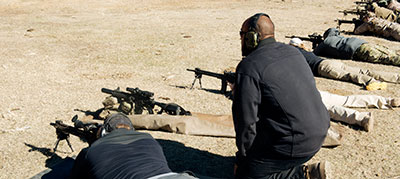
Final Thoughts
Follow Through Consulting’s Scoped Carbine class leaves you with usable, real-world skills. Training under stress using natural terrain pushes you beyond the square range. You quickly figure out your equipment’s limitations, along with your own. Skills developed while shooting across a field can also be applied to close-quarters scenarios. By pushing you outside of your comfort zone, you will be better prepared for the stress of a self-defense situation.













